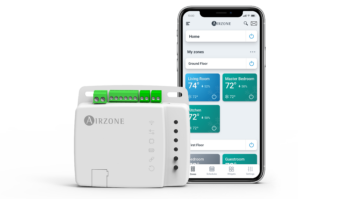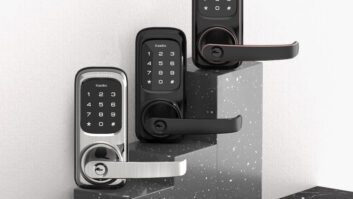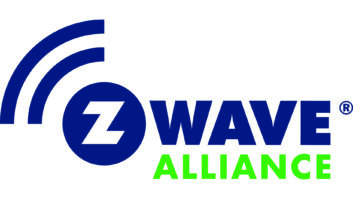
KIRKLAND, WASH. – Hub-less home-automation systems incorporating standardized Bluetooth mesh technology could hit the market sometime next year, thanks to a Bluetooth Special Interest Group (SIG) effort that’s on track, said SIG marketing director Errett Kroeter.
The Bluetooth SIG is developing a mesh-network variant, as-yet unnamed, for its low-power Bluetooth Smart standard. The SIG announced the creation of a smart mesh working group in February.
“Things are going well” to begin testing a prototype spec in the summer, deliver the prototype spec by year’s end to manufacturers for their own tests, and publish a final spec in 2016, he said. Kroeter did not say whether the final spec would be published in the first or second half of 2016.
After the spec is published, products could come quickly to market because a new Bluetooth chip doesn’t have to be designed and manufactured, he said. “Bluetooth mesh is being written as a Bluetooth profile and not as an update to the core Bluetooth 4.0 spec, so there’s no wait for a new chip,” he explained.
As a result, not only will new products be available quickly, but currently available home-automation products using proprietary Bluetooth-mesh technology will be firmware-upgradable to the standard, if the manufacturer allows it. Existing smartphones equipped with Bluetooth Smart are also expected to be firmware-upgradable, and Bluetooth Smart already appears in the “vast majority” of Bluetooth-equipped smartphones shipped today, the SIG said. That percentage will grow in 2018 to 96 percent of all mobile handsets, including smartphones and feature phones, the SIG said in citing analysts.
The group is focusing on bringing the new standard first to the residential and commercial-building automation markets, but it also envisions potential use cases in the automotive, industrial automation, and asset tracking markets, among others.
Grassroots Demand
Demand for Bluetooth-mesh products started at the grassroots level with companies such as Jasco’s GE brand, Samsung, Zuli, Avi-on Labs and Seed Labs developing products with proprietary versions of Bluetooth Smart-based mesh networking. Some of the products use a proprietary version developed by chipmaker CSR, including Jasco’s GE lighting.
Fearing that many proprietary incompatible versions of Bluetooth mesh would hit the market, the Bluetooth SIG stepped in to begin developing an official standard to encourage interoperability among different brands of products. “We want backward compatibility and interoperability between all Bluetooth devices,” Kroeter said.
The SIG’s spec will deliver full control of a full assortment of home-automation products, including light bulbs, light switches, smart plugs, thermostats, door locks, door and window security sensors, and the like.
Like the ZigBee and Z-Wave mesh-network technologies, Bluetooth mesh is a low-power technology, given that it leverages the low-energy Bluetooth Smart standard. The Bluetooth variant will therefore be suitable for use in battery-powered sensors such as door and window security sensors.
Hub-Less Design
Unlike ZigBee and Z-Wave, however, Bluetooth mesh dispenses with the need for a central home-automation hub that gets commands via Wi-Fi from a smartphone or tablet and relays the commands over a wireless ZigBee or Z-Wave mesh network to a home-automation device. A hub-less system improves system reliability because in hub-based systems, a hub failure keeps all devices in a home automation system from functioning, Kroeter explained.
Bluetooth mesh is hub-less because it dispenses with the hub-and-spoke architecture of today’s Bluetooth standard, and it enables direct communication via Bluetooth between a smartphone and one or more nearby Bluetooth-mesh devices at a time. Depending on the final SIG spec, the official standard could enable direct communication with more than one device at a time, a spokesperson said.
Like other mesh-network technologies, each Bluetooth mesh device will retransmit commands to other Bluetooth mesh devices until the commands reach their intended targets. Also like other wireless mesh-network technologies, Bluetooth mesh ensures whole-home coverage with a small number of devices, as little as three in the case of Bluetooth mesh. Bluetooth mesh, however, could control tens of thousands of devices, as does chipmaker CSR’s proprietary Bluetooth-mesh technology.
For remote monitoring and control from afar, consumers could plug an inexpensive Bluetooth mesh dongle into a home’s router, or they could use Bluetooth mesh built into future Bluetooth-mesh-equipped smart TVs or network-connected set-top boxes, Kroeter noted.
Other Advantages
Another advantage of hub-less home automation is speed, Kroeter added. “It’s instantaneous. It looks like a wired connection.” Devices wake up, connect, transmit a command, and go back to sleep in 3 milliseconds, he said.
Avi-on Labs also pointed out that hub-based systems don’t turn on multiple lights simultaneously but do so in sequence. In addition, hub systems dim multiple lights at different rates until they reach the programmed level, the company told TWICE.
Other factors will also propel the forthcoming Bluetooth mesh standard forward, Kroeter said. One is lower manufacturing costs compared to the competition. “Our manufacturing cost is very inexpensive because we have orders of magnitude higher volumes” compared to ZigBee and Z-Wave, he said. “When companies look at implementing technology, the bill of materials is a factor.”
The “trust factor” and 96 percent brand recognition will also carry the standard forward, he added.










